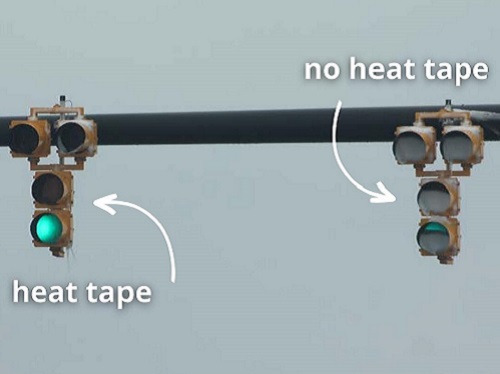The Utah Department of Transportation recently began installing new “heat tape” devices on traffic signals statewide to help keep those signals free of ice and snow during the winter, enabling motorists to see them clearly during winter storms.
[Above photo by the Utah DOT]
The heat tape, which sits on the underside of the hood/visor of individual signal lights, can be operated remotely by Utah DOT and integrates into existing traffic light wiring. The tape provides a heated cap for the signal light that melts away snow during severe weather, the agency said.

“We have been looking at ways to prevent snow buildup on traffic signals for years now — it has been more of an issue since the change to brighter, more energy-efficient LED [light emitting diode] signal lights,” said Mark Taylor, a traffic signal operations engineer at the agency, in a statement.
“After some discussions with our supplier, we’ve developed and are installing a solution that is both cost-effective and works well in most conditions,” he explained.
Snow-covered signal lights may be a relatively new sight for some state residents as, up until the mid-2000s, incandescent bulbs were used to power traffic signal light – and the heat from those lamps kept much of the snow at bay.
However, incandescent bulbs consumed nearly 20 times the electricity of LEDs, had to be changed every few years, and were less visible in many conditions.

“Until heat tape, the go-to method was to send out a technician with what is essentially a toilet bowl brush on a pole to clear the snow manually,” Taylor explained.
“If the packed snow was too iced up, sometimes the technician would need to go up 20 feet in the air with an ice scraper and scrape the ice away from the signal head,” he pointed out. “Anytime we put someone up in the air or on the ground in traffic, we introduce risk — and manual clearing always takes time. Heat tape, on the other hand, is on and working constantly at the flip of a switch.”
As a result, Utah DOT began experimenting with heat tape for traffic signals a few years ago and decided on a “simplified, no-frills design” heat-tape application co-created with a supplier that is turned on remotely during severe weather, then shut off to save energy when not needed.
The agency said it has installed the devices on more than 450 signals, with a focus on lights facing north and west that tend to get packed with snow and will continue this technology rollout throughout 2023 at intersections prone to snow buildup.
 States
States
Dina El-Tawansy Appointed Director of Caltrans
July 11, 2025 States
States

